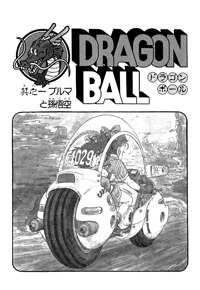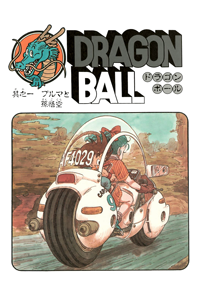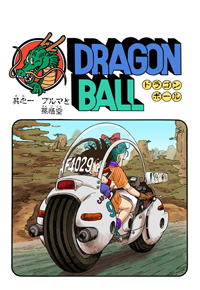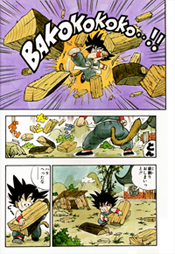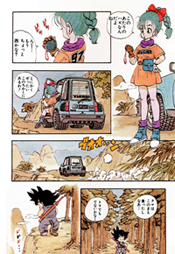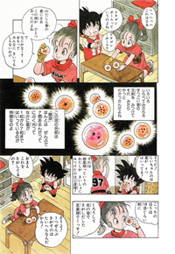ブルマと孫悟空
Buruma to Son Gokū
Bulma and Son Goku
Chapter Information
| Premiered: | 20 November 1984 (Weekly Shōnen Jump 1984 #51) |
| Corresponding: | Dragon Ball Episode 001, “Bulma and Son Goku” |
|
|
|
| Availability: |
|
Chapter Summary
“Once upon a time, deep in the mountains, thousands of kilometers from any city… At any rate, this bizarre story begins in such a place…”
A young boy prepares to do his daily chores of cutting wood. He grabs a slice of tree, hurls it in the air, and kicks it, creating smaller pieces of wood. He then proceeds to gather and stack the wood in a pile. With his chores done, he grabs a short staff, tells a small orb (which he calls “Grandpa”) he’ll return, and departs to find some food. Elsewhere, a young girl looks out over the mountain trying to find something. She pulls out a small device shaped like an oversize pocket-watch, and finds her object of inquiry is farther to the west. Satisfied that she is heading in the right direction, she gets into her car and drives off.
Meanwhile, the boy comes to a cliff, and, looking down it, decides that today is perfect for eating fish. He jumps off, catches a branch, and springs down onto the bank of the river. He then proceeds to take off his clothes and toss his tail into the river to do some fishing. A huge fish sees his tail and tries to eat what it assumes is merely a monkey, but the boy pulls his tail out of the way and the fish flies out of the water. He kicks the fish, killing it and knocking it into the river. He swims down to claim his prize, and happily heads back home with it.
As the boy gets to the road, he hears a noise. A car comes screaming around the bend, barely missing him and his fish. Angered, he yells at the “monster” trying to steal his food. He picks up the car and tosses it, with the car landing on its side, badly damaged. The girl then sticks her head out the window, pulls out a gun, and shoots the boy who just totaled her car. Seeing the boy in pain but apparently unharmed despite being shot, the girl freaks out and can’t believe he’s not dead. The boy prepares to attack with his staff, but the girl suddenly screams that she is human. The boy stops and thinks she looks different from him. She explains that it’s because he’s a man, and she’s just a delicate girl. Having never seen another human, He wonders where her tail is.
The boy wants to know about her monster, and asks if she caught it. She explains that it’s not a monster, but an automobile. He then asks her if she came from the city. The girl says she’s from the west, and he says she should come with him to his house to have a feast because she’s a woman. As they head off to his house, she says that he’s strong for such a little guy. The boy explains that his Grandpa trained him, and that’s why he’s so strong. The girl thinks that he’s weird, but his power could be of some use to her.
They arrive at his house, and the boy tells his Grandpa that he’s brought back a woman. The girl takes a look at “Grandpa”, and suddenly cries out. She goes over to the small orange orb resting on a pillow. The boy yells at her to not hurt Grandpa’s memento, and she pulls out two more balls just like it. The boy is shocked that she has two Grandpas. She explains to him that these are called “Dragon Balls”. She further explains that there are seven balls in total, and that in the middle they have stars, going from one star to seven stars.
The boy says his Grandpa’s ball has four stars, and the girl says it’s the Four-Star Ball. The first one she found was in her basement, the Two-Star Ball. She holds up her other one, the Five-Star Ball, which she says she found about ten days ago in a northern valley. The boy wants to know why she’s searching for them, so she explains that when all seven are gathered, Shenlong, the Dragon God, will appear and grant any one wish. The boy is amazed that these little balls can do all that. The girl says that the last person to use them became a king, but the balls were scattered, which is why she’s searching for them.
The girl says she knows what she’ll wish for: a dreamy boyfriend. That’s why she needs his Four-Star Ball, but he refuses to give up his Grandpa’s memento. She decides to bribe him, by lifting up her skirt and offering to let him cop a feel. He says he doesn’t want to, so she suggests that he join her in the search for the Dragon Balls. The boy finally agrees, so long as he gets to hold onto his ball. She’s happy and thinks to herself that he’ll make a good bodyguard for her.
The boy asks how they’ll find the other balls, if they don’t know where they are. She shows him her Dragon Radar, and explains that it detects the faint electromagnetic waves put out by the balls. She shows him on the radar that the next ball is about 1200 kilometers to the west. Thinking that it’s too far to walk, she looks in her pouch for something to use, since he destroyed her car. Realizing she doesn’t know the boy’s name, she asks him, and he introduces himself as Son Goku. Goku asks the same and she says her name is Bulma, which makes Goku laugh. Goku begins to make fun of her name, and she yells at him.
Bulma pulls a case out of her pouch and decides to use the No. 9 capsule. She throws it, it explodes, and as the smoke clears there is a motorcycle. Goku accuses her of using evil magic, and Bulma explains that it’s just a Hoi-Poi Capsule. They mount the motorcycle and drive off towards the next Dragon Ball. Down the road, Bulma takes a hill a little too fast and lands hard, coming to a stop. Bulma excuses herself, but Goku doesn’t understand, and she yells at him, saying she’s a lady and she has to pee. Goku thinks she’s strange for going all the way off into the bushes just to pee. Then he hears her scream, and runs to find out what happened.
A Pteranodon has grabbed Bulma, and Goku asks if she knows him. The Pteranodon says he is going off to talk with her, and tells Goku to wait here. He ties Goku to a tree, and flies off with her. Bulma yells at Goku to come help her, or she’ll get eaten. Goku unties himself with his tail, but realizes he can’t fly. He runs to the motorcycle, starts it, and gives chase. The bike goes up a hill and flies off into mid-air, and Goku jumps off towards the Pteranodon. Goku pulls out his Nyoi-Bō, tells it to grow, and whacks the Pteranodon over the head, causing him to drop Bulma. Now in free-fall, Bulma screams in terror, and Goku throws the Nyoi-Bō at her. He lands safely on the ground and finds Bulma, suspended from the Nyoi-Bō, which is stuck into the side of a cliff. Goku laughs as Bulma wets herself.
Chapter Notes
Weekly Shōnen Jump
- The series logo that appears on the title page for this chapter was subsequently used throughout the series in the magazine’s table of contents, and as a running title in the margin of a given issue’s Dragon Ball pages. However, it would appear only rarely after that in the manga proper, and would never again grace a chapter title page together with the Dragon emblem.
- When this chapter was first published, it marked the first of five consecutive weeks of color pages for the series (in other words, every chapter released in 1984), a relative rarity in Jump. The title page art of these first five chapters was made part of a contest where readers would choose their favorite for a chance to win a “deluxe panel” of the winning illustration. The results of this contest were reported on the title page of Chapter 12 in issue 1985 #12.
Chapter Title
- While the chapter title translates as “Bulma and Son Goku” within the context of the series, it fails to capture the bizarre pairing it makes in Japanese. At the time this chapter was first published, the characters of Bulma and Son Goku with respect to Dragon Ball had yet to be established, both in the comic itself and in the minds of readers. Thus, the first thing that would have come to readers’ minds would have been buruma (derived from the English word “bloomers”), a pair of close-fitting women’s gym shorts, and Sun Wukong, the self-styled “Handsome Monkey King” of the Chinese novel Journey to the West (upon which Dragon Ball was initially loosely based). The official English translation by Viz Media attempts to preserve this incongruity by rendering the title as “Bloomers and the Monkey King”.
Timeline
- The official timeline first used in Daizenshuu 7 places the events of this chapter on September 1st, AGE 749. This is reckoned by working back from the first concretely-known date of the series, which is the date of the 21st Tenka’ichi Budōkai on May 7th, AGE 750. (The date of the 21st Budōkai is itself derived by calculating back from the date of Piccolo’s world conquest precisely three years and two days later on May 9th, AGE 753.) At this point in the story, there are no apparent issues with this reckoning (even with it being established over 11 years after the chapter itself was first published), but certain things said by Bulma in the next chapter may call this date into question.
Art
-
In this chapter’s full-color pages, Goku is wearing a dark blue dōgi and Bulma’s hair and eyes are depicted as teal-colored. Both these traits were picked up by the anime, with Bulma’s hair remaining this color for the entire series, and Goku’s clothes staying blue for the remainder of the first story arc. However, in the next full-color pages two weeks later in Chapter 3, Goku’s dōgi changes to a now-familiar orange, and Bulma’s hair and eyes become the purple color they will remain for the rest of the series. No in-universe explanation is given for the change, although it may be surmised that Goku changed his clothes (as anathema as that is to his character), and that it is entirely within Bulma’s abilities as a genius inventor to change her hair color at a moment’s notice (and that she was wearing blue colored contact lenses). In reality, however, Akira Toriyama has stated that he simply chooses the colors to use in his illustrations as he is drawing them, and does not normally look back at his previous work to check for continuity issues.
Perhaps as a compromise, the digitally colorized edition keeps these initial colors from the first chapter until the end of Chapter 2, then abruptly switches to Goku’s orange dōgi and Bulma’s purple hair and eyes from Chapter 3 onwards.
- The fifth panel on page 8, and a combination of the fifth panel on page 4 and the first panel on page 5, are recreated from scratch in the final chapter of Jaco the Galactic Patrolman, published a full 28 years and 10 months later in September 2013. Comparing the two scenes is instructive in how Akira Toriyama’s art style has changed in three decades’ time. One may also observe that the license plate number on Bulma’s car in Jaco is different from the one in this chapter.
- The third panel on page 12 is recreated for the first page of Chapter 519, which is the final chapter in the series. Rather than an exact recreation of the scene, the action is dramatically reframed, with Bulma cautiously showing her Dragon Radar to a guarded Goku, at arms length with his Nyoi-Bō drawn. In fact, Bulma does not originally show Goku the Dragon Radar until much later in this chapter, in the first panel of page 20.
Milestones
- Aside from being the first chapter, as well as the first color chapter of the series, this is also the longest chapter in the series, at 30 pages; most other chapters were typically 13-15 pages in length. Due to being twice the length of typical chapters, the first tankōbon volume has only 11 chapters, while all others have at least 12. Likewise, the first kanzenban volume has only 14 chapters, while the others each have at least 15.
Characters
-
This chapter marks the first appearance of both Son Goku (孫悟空, son gokū) and Bulma (ブルマ, buruma). As mentioned in the note about the chapter title, Goku’s name is simply the Japanese pronunciation of Sun Wukong (孫悟空, sūn wùkōng), the self-styled “Handsome Monkey King” from the Chinese novel Journey to the West. Within Journey to the West itself, the name “Sun Wukong” is a religious name bestowed upon him; “Sun” (孫) is chosen because it resembles a character meaning “monkey” (猻) minus the element indicating an animal, while “Wukong” (悟空) means “enlightened to the emptiness of all things”. Within the context of Dragon Ball, Goku’s name is not given a concrete explanation until the final chapter of Jaco the Galactic Patrolman in 2013, where his foster-grandfather Son Gohan names him after himself, and for the fact that he fell from “the sky” (空, sora), although it must be noted that the character used for “sky” in Japanese does not have that meaning in Chinese.
At this point early on in the story, Goku is a clear analogue for the character he is based on. In fact, Toriyama at first planned him to be an actual monkey, complete with the Monkey King’s magical restraining headband, but eventually changed him to a human boy in a sailor suit (who still carried the Monkey King’s magical staff). However, when Toriyama’s editor, Kazuhiko Torishima, complained that this made him too plain, he added back the tail and dressed him in a martial-arts dōgi instead. Thus was born the “Son Goku” of Dragon Ball.
Bulma, meanwhile, comes from the Japanese word for “bloomers” (ブルマ, buruma), which there refer to close-fitting women’s gym shorts that were extremely common at the time. It has been commented that her name should therefore be rendered as “Bloomers” (or perhaps “Blooma” or “Bluma“) in English, but the “Bulma” spelling, having appeared on her clothes in the very first chapter, has won out in the vast majority of fan circles (as well as most official translations). In terms of characterization, Bulma is an analogue of Journey to the West‘s Tripitaka, the Buddhist monk charged with bringing Buddhist scriptures to China and the catalyst for the Monkey King’s journey. However, where Tripitaka is depicted as feminine (and usually played by women in live action), Bulma is actually female. And while Tripitaka is a monk devoted to moral uprightness, Bulma is motivated by selfish reasons, and has no qualms about using her “feminine wiles” in order to get what she wants (though this chapter sets a trend in that using her sexuality in this way usually backfires). What has not changed is that she, like Tripitaka, invariably becomes a damsel-in-distress to be rescued in spite of her great intellect and talents.
- Goku’s “dead grandpa” is first mentioned in this chapter, although he is not named, as Son Gohan, until Yamcha recognizes Goku’s Nyoi-Bō as having belonged to him in Chapter 8, and he himself does not appear until Chapter 105 (and even then, he does not reveal himself until Chapter 108). All of this is irrelevant (and probably not thought up yet) at this point in the story, however, as the establishment of his existence primarily serves as a plot device to explain why Goku lives by himself, why he knows martial arts, and why he is in possession of a Dragon Ball.
- This chapter features the first mention of Shenlong (神龍, shén lóng, transliterated shenron), the “God of the Dragons” who will grant any wish, although it will not appear until the end of Chapter 19. As with the names of the Dragon Balls themselves (see below), the Dragon’s name is written in Chinese, with a katakana transliteration next to the Chinese characters.
- This chapter also features the (first and last) appearance of a Pteranodon, which, despite its speaking role, is never given a name. Instead, it is merely referred to as “Pteranodon” (プテラノドン, puteranodon) in guidebooks and the credits for the first episode of the TV show.
Items
- This chapter marks the first appearance of the Dragon Balls of the series title. Apart from the title of the series, “Dragon Ball” is primarily written using katakana (phonetic characters) spelling out a rough approximation of the English: ドラゴンボール (doragon bōru). However, as on Page 15 of this chapter, this pronunciation is occasionally also combined with the Chinese characters 龍球, literally “Dragon Ball”, to convey the meaning. After the end of the series, this kanji gloss was largely replaced in promotional materials with 龍珠 (same meaning), which is the name for the Dragon Balls in the official Cantonese and Taiwanese translations.
-
Each of the individual Dragon Balls is referred to by a Chinese name based on the number of stars it has. In this chapter, Goku’s Four-Star Ball is the Sì xīngqiú (四星球, transliterated sūshinchū), and the Two-Star Ball and Five-Star Ball that Bulma has found thus far are the Èr xīngqiú (二星球, arushinchū) and Wǔ xīngqiú (五星球, ūshinchū), respectively. In this case, the portion “__ xīngqiú” means both “__ Star Ball” and simply “__ Stars”, as 星球 as a compound in Chinese can just mean “star”.
Incidentally, the name of the Two-Star ball violates Chinese grammar somewhat, as while the name Èr xīngqiú (二星球) literally means “Two Star Ball”, the character 二 is only used to mean the number “two” as such, rather than two of something. The name of this particular Dragon Ball would be better expressed as Liǎng xīngqiú (兩星球, transliterated ryanshinchū), and this pronunciation is indeed what Toei Animation went with when creating Dragon Ball GT in 1996 (although the spelling in Chinese characters remained the same).
- Goku’s Nyoi-Bō (如意棒, roughly “obedient staff”) makes its first appearance here. As with the character himself, this is an item directly borrowed from Journey to the West. There, it is known as the “Obedient Gold-Banded Staff” (如意金箍棒, Chinese: rúyì jīngū bàng, Japanese: nyoikinkobō) which, in addition to growing and shrinking according to the user’s will, is also said to weigh roughly eight metric tons. It is never explicitly clear how heavy the Nyoi-Bō actually is in Dragon Ball, but Tenshinhan is later able to pick it up without any apparent effort in Chapter 161, suggesting it weighs roughly the same as an ordinary wooden staff of the same size.
-
Bulma’s Hoi-Poi Capsules (ホイポイカプセル, hoipoi kapuseru) make their debut in this chapter. Their naming follows a fairly precise description of what they are and how they are used: hoi is a sound made when tossing something, poi is the sound of something being tossed (as in ポイ捨て poi-sute, “littering”), and “capsule” is self-explanatory.
In addition to being referred to by their full name (which is no longer done in the story proper after the Rabbit Gang incident in Chapter 16, likely because the full phrase is unwieldy), it is not yet shown in the story that these Capsules are made by Capsule Corporation (introduced in Chapter 68), or that their inventor is Bulma’s own father, Dr. Brief (first appearing in Chapter 69). It is likely that, at this point in the story, Toriyama had simply not come up with these concepts, and that Bulma could simply have purchased these items at market (although their cost would certainly seem to indicate, even at this early phase, that she comes from a background of significant financial means).
Vehicles
- The car Bulma drives at the beginning of the chapter is a Renault 5 Turbo, as noted in Daizenshuu 4: World Guide. This is not the first time that Toriyama had incorporated this model into his manga, having previously depicted it in at least two chapter title pages for Dr. Slump (including Chapter 108: “The Crazy Honeymoon, Part 4” and Chapter 149: “The Konkon Morph Helmet”.). However, Toriyama comments that while he liked the design, drawing a real car in a deformed style required drawing in everything just like the real thing, which was a pain. He notes that, in such situations, a plastic model comes in handy (though he doesn’t mention whether that’s to use as a reference, or to relieve the stress of drawing by building models instead).
Weapons
- Bulma’s sidearm, which she uses to shoot Goku, appears to be a Walther PPK. She continues to carry it, holstered, until the following chapter, after which it is not seen again; presumably, it was packed away in one of her capsules, and thus lost in Chapter 7 when she loses her case.
Anime Connections
- The series logo that appears on the title page of this chapter was made the official logo of the Dragon Ball TV series over the entirety of its run, from 1986 to 1989. It was also used in numerous items of tie-in merchandise during the same period.
- A scene based on the title page’s artwork appeared in the Dragon Ball TV series’ first three ending animations. The scene’s arrangement was slightly reconfigured in the animated version and the background was replaced with something we frequently see early on in the series.
Author’s Comment
-
Each issue of Weekly Shōnen Jump featured short comments from the various series’ authors, giving fans a brief insight into their current thoughts, ranging from series-related announcements to trivial happenings in their personal lives. Akira Toriyama’s comments from this issue were:
休む間もなくまた登場させてもらいました!うれしいけど悲しい。でもガンバリまっせ!!<明>
Here I am again, and without having had any time to rest! I’m happy, but sad too. Still, I’ll do my best!! <Akira>This comment, aside from being the very first Toriyama Jump comment for the series, is also one of those reprinted in Daizenshuu 7. Toriyama’s previous serialization Dr. Slump had ended in the 1984 #39 issue, so it had been exactly 12 weeks since he had last checked in with fans. Towards the end of Dr. Slump‘s run, he traveled to China with his wife, and used the subsequent break to refine his ideas for Dragon Ball, but still had basically no idea where it was going when the series got underway.
With this entry, Toriyama’s self-portrait in the table of contents also changes from the bird he had used throughout Dr. Slump to a man in a “Mao suit“, a kind of clothing which was commonly worn in mainland China at the time the series began. He kept this illustration for the remainder of the series, before switching to variants of his familiar robotic avatar for subsequent one-shots and short series from 1996 onward.
Page Breakdown
The majority of the Dragon Ball series was drawn in black and white, but chapters were occasionally published with color pages. This breakdown notes how many full-color, limited-color, and black-and-white pages appeared in this chapter. As the tankōbon volumes were not released with these colors intact, any color pages shown are taken from the kanzenban release.

